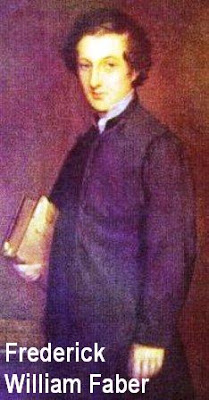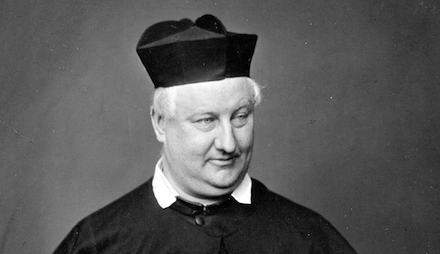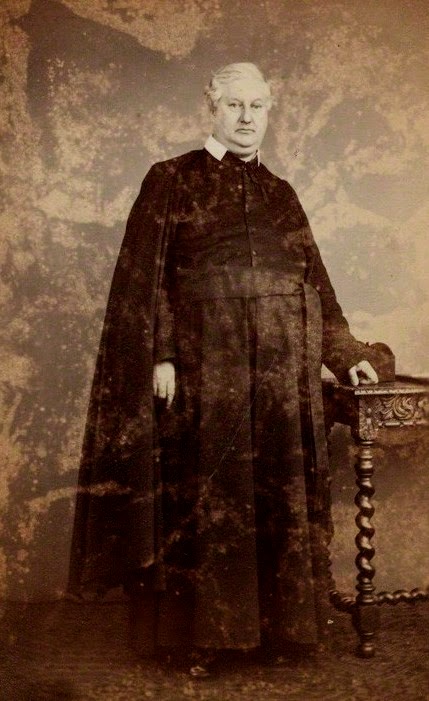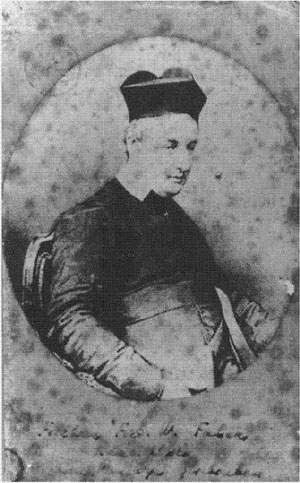 Fr Faber as a young man
Fr Faber as a young man
Oratorian and devotional writer, b. 28 June, 1814, at Calverley, Yorkshire, England; d. in London, 26 Sept., 1863. After five years at Harrow School he matriculated at Balliol in 1832, became a scholar at University College in 1834, and a fellow of that College in 1837.
Of Huguenot descent Faber was divided in his university days between a tendency to Calvinism, in the form of individual pietism, and the Church theory then being advocated by Newman. Eventually the latter triumphed, and Faber threw himself unreservedly into the Tractarian movement and cooperated in the translation of the works of the Fathers then in progress.
He received Anglican ordination in 1839, and took work as a tutor, till, in 1843, he was appointed Rector of Elton, Northamptonshire. During the years 1839-1843 Faber made two continental tours, and his letters give strikingly poetic descriptions of the scenes he visited; they glow with enthusiasm for Catholic rites and devotion. On his return to Elton in 1844, he established the practice of confessions, preached Catholic doctrine, and wrote the life of St. Wilfrid, openly advocating the claims and supremacy of Rome.
 In October 1845, Newman was received into the Church at Littlemore; in November, Faber was also received by Bishop Waring, at Northampton. In 1846, Faber established a religious community, the “Brothers of the Will of God” or “Wilfridians,” as they were called from St. Wilfrid, their patron, at Cotton Hall, near Cheadle, Staffordshire, the gift of the Earl of Shrewsbury. In 1847 Faber was ordained priest and with his zealous community, now forty in number, converted the whole parish, except “the parson, the pew-opener, and two drunken men.”
In October 1845, Newman was received into the Church at Littlemore; in November, Faber was also received by Bishop Waring, at Northampton. In 1846, Faber established a religious community, the “Brothers of the Will of God” or “Wilfridians,” as they were called from St. Wilfrid, their patron, at Cotton Hall, near Cheadle, Staffordshire, the gift of the Earl of Shrewsbury. In 1847 Faber was ordained priest and with his zealous community, now forty in number, converted the whole parish, except “the parson, the pew-opener, and two drunken men.”
In 1848, Newman arrived from Rome with his new congregation of the Oratory of St. Philip Neri, and established himself at Old Oscott, Birmingham, then renamed Maryvale. With singular disinterestedness, Faber placed himself under Newman as a simple novice, taking with him all his community who were willing to follow his example. In 1849 he was sent by Newman to found the Oratory at King William Street, London, and was appointed its superior.
In the poor chapel there, once a tavern, Faber laid the foundation of his future works. Poor schools, nightly services, and sermons with hymns and processions of the Blessed Sacrament, till then unknown, formed its chief characteristics. Faber’s hymns, composed especially for these services, display a combination of accurate theological doctrine, fervent devotion, musical rhythm, and true poetic talent. As a preacher he was remarkable for his delivery, choice of expression, absence of gesticulation, and personal exhortations of surprising force.
In 1847 Faber began the publication of “Lives of the Modern Saints,” not as biographies, but as showing the growth of sanctity under the operation of grace and the supernatural perfection attained. The series of forty-nine Lives supplied a great want of the time and, after some opposition, met with full approbation. His knowledge of the spiritual life and the extent of his theological and ascetic reading were seen in the eight works that now came from his pen: “All for Jesus”, 1853; “Growth in Holiness”, 1854; “The Blessed Sacrament”, 1855; “The Creator and the Creature”, 1858; “The Foot of the Cross”, 1858; “Spiritual Conferences”, 1859; “The Precious Blood”, 1860; “Bethlehem”, 1860.
The many foreign translations of these works, their circulation now maintained for more than fifty years, their constant quotation by spiritual writers, have raised their author to the rank of a master in mystical theology. He wrote also two volumes of “Notes on Doctrinal Subjects” (1866), giving the skeleton of various sermons and of two projected works, “Calvary” and “The Holy Ghost.” A volume of poems, various essays, and other minor works are also from his pen. The fascination and grace of his presence rendered him personally attractive, while as confessor his sympathy with souls in trouble, his spiritual insight, and his supernatural unworldliness, gave to his counsel a lifelong point and force.
 The Oratory removed to South Kensington in 1854, and there Faber spent the remaining nine years of his life, occupied primarily in establishing his community on the strict observance of St. Philip’s Institute, being convinced that fidelity to its Roman model was its one vital principle.
The Oratory removed to South Kensington in 1854, and there Faber spent the remaining nine years of his life, occupied primarily in establishing his community on the strict observance of St. Philip’s Institute, being convinced that fidelity to its Roman model was its one vital principle.
The sacraments, prayer, including the reverent performance of the ecclesiastical functions, and the daily Word of God were St. Philip’s weapons, and Faber would never engage in other external works, however good. Unswerving loyalty to the Holy See was his watchword, and devotion to the Mother of God was for him the safeguard of faith and the source and support of true piety.
BOWDEN, The Life and Letters of Frederick William Faber, 2nd ed. (London, 1888); FABER, A Brief Sketch of the Early Life of F. W. Faber (London, 1869); Civilta Cattolica (Rome, 3 and 13 Aug., 1872), tr. (London, 1872); Catholic World, X, 145; III, 287; GILLOW, Bibl. Dict. of Eng. Cath., II, 207-219.
Henry S. Bowden (Catholic Encyclopedia)


No comments:
Post a Comment